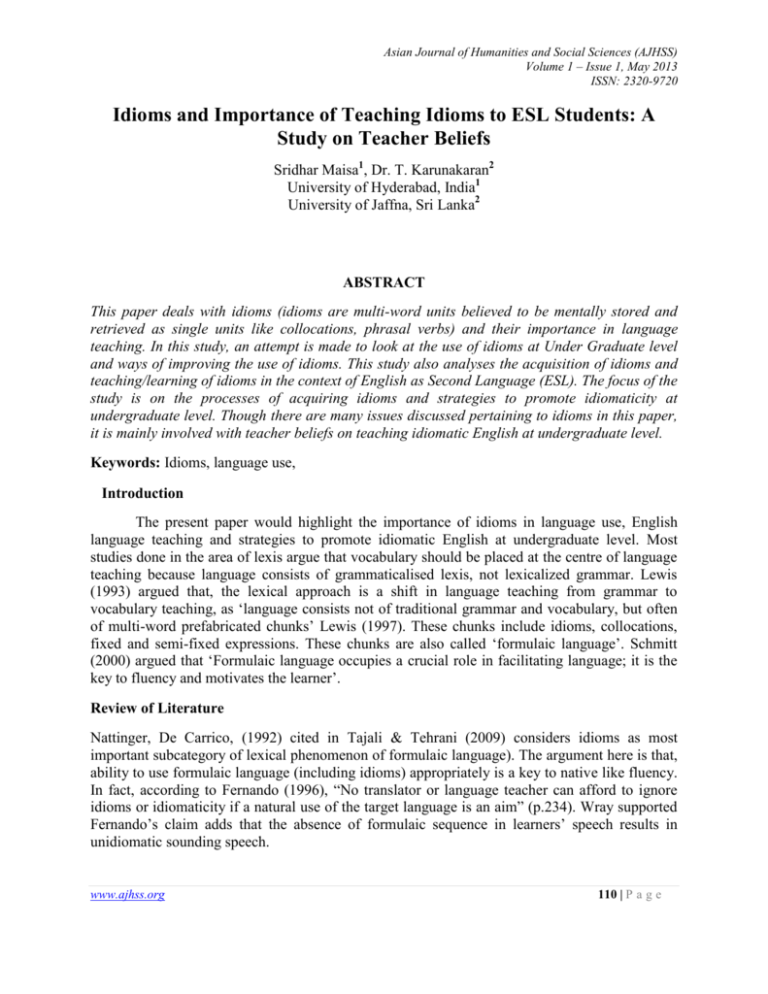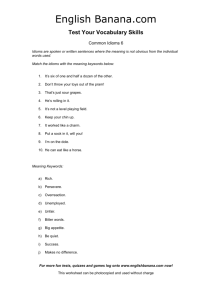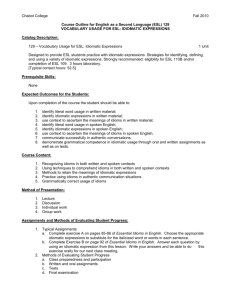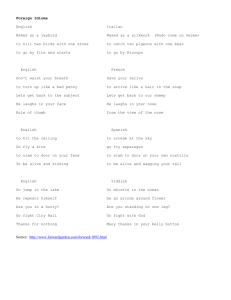Idioms and Importance of Teaching Idioms to ESL Students: A Study
advertisement

Asian Journal of Humanities and Social Sciences (AJHSS) Volume 1 – Issue 1, May 2013 ISSN: 2320-9720 Idioms and Importance of Teaching Idioms to ESL Students: A Study on Teacher Beliefs Sridhar Maisa1, Dr. T. Karunakaran2 University of Hyderabad, India1 University of Jaffna, Sri Lanka2 ABSTRACT This paper deals with idioms (idioms are multi-word units believed to be mentally stored and retrieved as single units like collocations, phrasal verbs) and their importance in language teaching. In this study, an attempt is made to look at the use of idioms at Under Graduate level and ways of improving the use of idioms. This study also analyses the acquisition of idioms and teaching/learning of idioms in the context of English as Second Language (ESL). The focus of the study is on the processes of acquiring idioms and strategies to promote idiomaticity at undergraduate level. Though there are many issues discussed pertaining to idioms in this paper, it is mainly involved with teacher beliefs on teaching idiomatic English at undergraduate level. Keywords: Idioms, language use, Introduction The present paper would highlight the importance of idioms in language use, English language teaching and strategies to promote idiomatic English at undergraduate level. Most studies done in the area of lexis argue that vocabulary should be placed at the centre of language teaching because language consists of grammaticalised lexis, not lexicalized grammar. Lewis (1993) argued that, the lexical approach is a shift in language teaching from grammar to vocabulary teaching, as ‘language consists not of traditional grammar and vocabulary, but often of multi-word prefabricated chunks’ Lewis (1997). These chunks include idioms, collocations, fixed and semi-fixed expressions. These chunks are also called ‘formulaic language’. Schmitt (2000) argued that ‘Formulaic language occupies a crucial role in facilitating language; it is the key to fluency and motivates the learner’. Review of Literature Nattinger, De Carrico, (1992) cited in Tajali & Tehrani (2009) considers idioms as most important subcategory of lexical phenomenon of formulaic language). The argument here is that, ability to use formulaic language (including idioms) appropriately is a key to native like fluency. In fact, according to Fernando (1996), “No translator or language teacher can afford to ignore idioms or idiomaticity if a natural use of the target language is an aim” (p.234). Wray supported Fernando’s claim adds that the absence of formulaic sequence in learners’ speech results in unidiomatic sounding speech. www.ajhss.org 110 | P a g e Asian Journal of Humanities and Social Sciences (AJHSS) Volume 1 – Issue 1, May 2013 ISSN: 2320-9720 Crick, Pawley and Syder (1983) cited in Tajali & Tehrani(2009) argued that native speakers’ fluency not only depends on vocabulary which is stored as individual words , but also as part of phrases and larger chunks , which can be retrieved from memory as a whole, reducing processing difficulties. On the other hand, ESL learners who only learn individual words will need a lot more time and effort to express themselves. Consequently, it is essential to make students aware of chunks and their usage in language production. There is a common assumption that the more words a learner knows, the larger the learner’s vocabulary knowledge. However, there is another dimension to vocabulary knowledge that should be considered, namely how far a learner knows the combinatory possibilities of a word. Some linguists call them ‘lexical phrases’ or ‘ lexical items’, others prefer the term ‘multi-word chunks’ or just ‘chunks’ of language (Moon, 2001). Miller (1956) cited in Ellis (2001) coined the term ‘chunking’. It is the development of permanent sets of associative connections in longterm memory and is the process which underlines the attainment of automaticity and fluency in language. Whatever the term, they are an important feature both in language use and language acquisition. These multi-word chunks or expressions are namely: idioms, proverbs, sayings, phrasal verbs and collocations. This aspect of vocabulary knowledge has until recently been largely ignored. Idioms Words constitute the genesis of all languages, and learning any language either the first or any subsequent one is deemed pointless without learning words. Moreover, the coining of new words never stops, nor does the acquisition of words. This process is evident even in our first language; we are continually learning new words and adding new meanings to the old ones we already know. However, there are some word categories like idioms, collocations, proverbs and fixed expressions which are neglected by language teachers. Idioms, collocations and proverbs are word expressions that have specific meaning (i.e cultural specific) and choice of words. Much of this lexis consists of sequences of words that have a strong tendency to occur together in discourse, including a wide and motley range of expressions such as phrasal verbs, compounds, idioms, and collocations referred to collectively as multiword lexical items, prefabricated units, prefabs, phraseological units, fixed phrases, formulaic sequences, etc. We find these expressions mostly in native speakers’ language. Among all above mentioned multiword expressions idioms are more neglected word expressions in language use and learning. Idiom is “a group of two or more words which are chosen together in order to produce a specific meaning or effect in speech or writing” Sinclair (1991:172). In other words, an idiom is an expression, which is a term or a phrase whose meaning cannot be deduced from the literal definitions and the arrangement of its parts, but refers instead to a figurative meaning that is known only through common use. The term idiom is defined as an institutionalized multiword construction; the meaning of this cannot be fully deduced from the meaning of its constituent words, and which may be regarded as a self contained lexical item (Webster’s Unabridged Dictionary of the English Language, 1989). A form of expression, grammatical construction, phrase, etc, peculiar to a language; a peculiarity of phraseology approved by the usage of a language, and having a signification other than its grammatical or logical one (The Oxford English Dictionary , 1933). www.ajhss.org 111 | P a g e Asian Journal of Humanities and Social Sciences (AJHSS) Volume 1 – Issue 1, May 2013 ISSN: 2320-9720 Idioms are specific to one culture and language and their meaning is peculiar to that language (institutionalised), otherwise ,idioms defined as proper language of a people or country, dialect; specific character of a language; expression peculiar to a language ( The Oxford Dictionary of English Etymology, 1966). When idioms in one language are translated in to other languages they may lose their actual meaning because many idioms are specific to the culture. Idioms are special mode of expression, use or grouping of words, peculiar to a specific language (The Universal Dictionary of the English Language, 1958). Idioms are a colourful and fascinating aspect of English; they are commonly used in all types of languages, informal and formal, spoken and written. Learners’ language skills will increase rapidly if learner can understand and use them confidently and correctly. (Cambridge Idioms Dictionary, 2010:vi) According to Stathi (2006:27), the term ‘idiom’ can refer to two types of fixed expressions. First, in a narrow sense, idioms are ‘expressions whose idiomaticity is semantic; typical expressions are kick the bucket, spill the beans etc. Second, idiomaticity is a formal property of expressions and is more or less equated with the fixedness of form; for example, by and large. According to Mc Carthy & O’Dell (2008) idioms are connected with the themes of animals, the sea, sports, parts of the body, food and drink, colours, names of people and places, sight, hearing, taste, smell and touch. We use idioms to describe physical appearance, character and personality, work and success, health and illness. The origin of idiom as stated in different sources is as follows. 1) Many idioms are formed from work and technology, a large number of idioms come from a time when far more people worked on the land, there are many idioms which refer to farm animals, for example, the black sheep of the family, take the bull by the horns, don’t count your chickens, etc. 2) Some idioms are formed from rural life, transport, for example, strike while the iron is hot, put somebody through the mill, eat like a horse, put the cart before the horse, etc. 3) Many idioms came into existence from science and technology, for example, she has a short fuse, we are on the same wave length, I need to recharge my batteries etc, 4) Every year many idioms enter into the English language from the world of sports and entertainment, for example, have a good innings, dice with death, behind the scenes, play the second fiddle, etc. 5) Many idioms have entered English from literature and history, for example, sour grapes, the goose that laid the golden eggs, the streets are paved with gold, etc. 6) Idioms came from the Bible, Shakespeare’s works, for example, the salt of the earth, fall by the way side, your pound of flesh, ships that pass in the night, etc. 7) There are a large number of idioms in which a part of the body represents particular quality or ability, for example, use your head, the idea never entered my head, she broke his heart, he opened his heart, I speak from the bottom of my heart, the news finally reached her ears, keep your mouth shut. etc, 8) Many idioms come from feelings and emotions, for example, give him a black look, lose your bearings, in seventh heaven, in high spirits, it was love at first sight, come out of your shell. www.ajhss.org 112 | P a g e Asian Journal of Humanities and Social Sciences (AJHSS) Volume 1 – Issue 1, May 2013 ISSN: 2320-9720 Many idioms have unusual grammar. In some cases a word that is usually a verb, adjective, conjunction or preposition appears as a noun: a) Adjectives as nouns, for example, all of a sudden, through thick and thin, b) Verbs as nouns, for example, the do’s and don’ts, on the make c) Conjunctions and prepositions as nouns, for example, ifs and buts, on the up and up, the ins and outs, d) Uncountable nouns seeming to be countable, for example, the living daylights and in all weathers.( Stathi, 2006 ) Idiom is “a phrase which doesn't mean anything literally by itself, but can be used in a sentence to mean something indirectly. It is specific kind of vocabulary or jargon which is used in specific contexts.” (Gumpel, 1974 : 12 as cited in Fernando & Flavell, 1981;28-28) . For example, a blessing in disguise (to be something which has a good effect, although at first it seemed that it would be bad or not lucky), Blood is thicker than water ( which means family relations are closest) , Once in a blue moon ( which indicates rare occurrences ) , Break a Leg( wishing good luck), Dry Run ( rehearse). Idioms are thought to be relatively frozen and to have severe grammatical restriction’ (Moon, 1997:47), and so it might be generally taken that they do not permit any lexical or syntactic modification, but they have greater possibilities of modification than might be expected (Mostafa , 2010) Most of the Scholars discussed above- conclude that: 1) The meaning of an idiom is not the result of the compositional function of its constituents; If the idioms meaning predictable from constituent words, then it is decomposable idioms ( e.g., pop the question, spill the beans ) if meaning is not predictable from idioms constituent parts, such idioms are non-decomposable idioms ( Gibbs et al 1999) 2) An idiom is a unit that either has a homonymous literal counterpart or at least individual constituents that are literal, though the expression as a whole word need not be interpreted literally; 3) Idioms constitute set expressions in a given language, these set expressions are fixed in a language, here, set expressions are peculiar to particular language but we may see similar idioms in other language. 4) Idioms are institutionalized (specific to culture or language). Research Questions a) Do idioms promote language skills of UG language learners? b) What are the strategies to promote idiomatic English at UG level? Hypothesis 1) Teaching idioms with specific strategies will help ESL learners to understand and produce idioms. 2) Knowledge of idioms improves the learners’ language. Research Methodology www.ajhss.org 113 | P a g e Asian Journal of Humanities and Social Sciences (AJHSS) Volume 1 – Issue 1, May 2013 ISSN: 2320-9720 Research Methodology consists of research approach, research type, tools and subjects. The present research paper followed only qualitative approaches. The research type is exploratory research. The subjects of my research paper are five teachers who are teaching at Undergraduate colleges in Hyderabad. I would like to work further with other research tools and subjects, would be second Undergraduate students, who are studying in different Osmania University affiliated colleges. The research tool used in the present research paper is only Questionnaire for teachers there approximately twenty five questions are there in teacher questionnaire. There are closed and open ended questions. Likert scale is used to find some responses from teachers. I have collected data from college/university teachers to know their beliefs about teaching idiomatic expressions. I have analyses data to know teachers beliefs about teaching methodology, material and testing particular to teaching idiomatic English context. There are some closed questions and some open ended questions. Teachers gave mixed responses to the questionnaire. Data Analysis The importance (place) given to the idiomatic expressions among other contents of vocabulary course(s) T Teacher Responses T1 Yes, satisfied with the importance (place) given to the idiomatic expressions among other contents of vocabulary T2 To some extent, idiomatic expressions have only two marks. The weighting again can be increased T3 Yes, satisfied with the importance (place) given to the idiomatic expressions among other contents of vocabulary T4 Yes, satisfied with the importance (place) given to the idiomatic expressions among other contents of vocabulary T5 No, I am not happy with the importance given to the idiomatic expressions because; I feel sometimes that most of the writers didn’t felt the necessity to train students in the field of Idioms and phrases. Three teachers (T1,T3 and T4) agreed that they were satisfied with the importance given to idiomatic expressions among other vocabulary items. One teacher (T2) agreed only to some extent and felt that idiomatic expressions were given very less weight in test. Less importance to idioms in examination de-motivates the teacher as well as learners to some extent. T5 was unhappy with the amount of importance given to idiomatic expressions, and opined that the text itself lacked idiomatic expressions. So it is essential to include idioms in the textbooks to promote their idiomatic knowledge in English. Are your students conversant with the terms idioms/idiomatic expressions? www.ajhss.org 114 | P a g e Asian Journal of Humanities and Social Sciences (AJHSS) Volume 1 – Issue 1, May 2013 ISSN: 2320-9720 T Teacher Responses T1 Yes, the student doesn’t make an effort to speak in English, where teacher tries to use them in his/her conversation. T2 Yes, because it is taught in the class room. T3 Yes, the students who are from English medium background can speak few idioms in their colloquial language. T4 Yes, mostly the common idioms and the formal idioms provided, so they enjoy using them easily. T5 No, my students generally suffer from Mother tongue influence (MTI) and they feel very hesitant to use idioms in their communication. Four teachers (T1,T2,T3 and T4) agreed that students conversant with the terms idioms/idiomatic expressions but they gave different reasons. T2 reported that they were conversant in English due to classroom teaching. T1 responded that students didn’t make efforts to speak in English, whereas teacher tried to use them in their conversations. Respondent T3 mentioned that students who were from English medium background can use few idioms in their colloquial language. T4 responded that students can easily enjoy the usage of some common idioms and formal idioms if teacher provided them in the class. T5 responded that students have mother tongue influence (MTI), so they felt very hesitant to use idioms in their communication. According to the majority of respondents, teaching idioms in the class certainly facilitates learning idiomatic language. In this regard, teachers should aware about students who come from vernacular language background or regional medium. Is idiom one of the most difficult areas of English for the foreign learners? T Teacher Responses T1 Yes, the student finds it difficult to catch the hidden meaning and gets confused with some other expression T2 Yes, unless explained it is difficult to understand T3 Yes, idioms create lot of confusion, while understanding the meaning T4 No, as vocabulary is important and needed, they do not find it difficult T5 No, I think English is one of the languages where we can really enjoy the idiomatic expressions. Teachers (T1, T2 and T3) agreed for this question. The reasons vary from teacher to teacher. T1 responded that students found it difficult to catch the hidden meaning (idiomatic meaning) and www.ajhss.org 115 | P a g e Asian Journal of Humanities and Social Sciences (AJHSS) Volume 1 – Issue 1, May 2013 ISSN: 2320-9720 got confused with some other expressions. T2 responded that unless explained, idioms were difficult to understand. T 3 responded that idioms create lot of confusion in understanding the meaning. Teachers (T4 and T5) disagreed to this question. T4 responded that vocabulary is important and students need it, so they do not find it difficult. T5 responded that idioms are really enjoyable to learn in the English language. There were mixed responses to this questionsome teachers believe that idioms are difficult for foreign learners at the same time some teachers believe that idioms were not difficult to them. But majority of teachers believed and agreed that idioms were one of difficult areas of English for the foreign learners. Idiomatic expressions (IEX) are important in everyday English (language) use T Teacher Responses T1 No, it is not necessary because communicating in simple English language is preferable and communication in the right sense is enough. T2 Yes & no. it is difficult for non-English speakers to understand. It can be used in total English environment. T3 Yes. Idioms will add to the beauty of the language. T4 Yes, idioms convey (at times) the ideas in ornamental way. It adds beauty to one’s language. T5 Yes, it will improve vocabulary which in turn is an added advantage for any language learner. Teachers (T2, T3, T4 and T5) agreed to the importance of idiomatic expression in everyday language use. T3 responded that idioms added advantage to the language. T4 responded that idioms were ornamental to the language and idioms add beauty to one’s language. T5 responded that idioms would improve vocabulary knowledge which in turn was an added advantage for any language learner. T2 gave mixed answer to this question and thought that idioms were difficult for non-English medium students. One teacher (T1) responded that idioms were not important in everyday English language usage because communicating in simple English language is preferable and communication in the right sense is enough. But, the majority of teachers supported the main argument that is idiomatic expressions (IEX) are important in everyday English usage. The problems and difficulties students encounter while learning idiomatic expressions T www.ajhss.org Teacher Responses T1 Most of the students from regional medium background, they find it difficult to learn idiomatic expressions T2 Not much, we have English medium students 116 | P a g e Asian Journal of Humanities and Social Sciences (AJHSS) Volume 1 – Issue 1, May 2013 ISSN: 2320-9720 T3 Students are often confused; they cannot identify the meaning of it immediately. T4 They don’t know about dictionary of idioms. T5 Students confuse and hesitate to speak in the class. Some of them have a laid back attitude. T1 responded that most of students from regional medium students, therefore, they found it difficult to learn idiomatic expressions. T2 responded that most of learners from English medium background, so that they didn’t have much problems. T3 responded that most of the students were confused and they couldn’t identify meaning immediately. T4 responded that learners were not aware of idioms dictionary and that might be one reason for why they felt difficult about idioms. T5 responded that students are confused and hesitate to speak in the class; some of them have a laid back attitude. All teachers agreed that there were some problems and difficulties students encounter while learning idiomatic expressions. Knowledge of idiomatic English can promote language fluency T Teacher Responses T1 To some extent, because knowledge of idiomatic English improves the language capacity and hence it can promote language fluency T2 Knowledge of idiomatic English can enhances the language fluency to certain extent T3 Yes, knowledge of idiomatic English helps in expressing the views in a flowery language T4 Yes, one can convey their messages in a better beautiful manner, in shorter way. T5 Yes, definitely, it will be an added advantage for any communicator in English. Teachers (T3, T4 and T5) responded knowledge of idiomatic English can promote language fluency. T3 responded that knowledge of idiomatic English can help in expressing the views in a flowery language. T4 responded that one can convey idiomatic message in a better beautiful manner in a shorter way. T5 responded that it would definitely add advantage for any communicator in English. T1 responded that to some extent knowledge of idiomatic English improve the language capacity and promote language fluency. T2 responded that the knowledge of idiomatic English can enhance the language fluency to certain extent. The majority of teachers responded that knowledge of idiomatic English can promote language fluency. Therefore, it is concluded that the knowledge of idiomatic English can promote language fluency of the leaner. www.ajhss.org 117 | P a g e Asian Journal of Humanities and Social Sciences (AJHSS) Volume 1 – Issue 1, May 2013 ISSN: 2320-9720 Teaching idioms with specific strategies can help the learner to understand and produce idioms T Teacher Responses T1 To some extent. Some specific strategies can evoke interest among the students and helps the student to understand them. If the idiomatic expressions are understood, he/she would be able to produce them or use them. T2 Some extent. Teaching depends on the reception of students from one batch to the other. T3 No T4 Yes, there can be crossword puzzles, paraphrasing, match the following and topic related teaching method can be employed. T5 Yes, innovative teaching methodology can create interest in it. Teachers (T4 and T5) agreed that teaching idioms with specific strategies can help the learner to understand and produce idioms. T5 responded that innovative teaching methodology can create interest among learners. T4 responded that crossword puzzles, paraphrasing, match the following and topic related teaching methods can be employed as strategies. Teachers (T1 and T2) responded that to some extent some specific strategies can evoke interest among the students and helps the student to understand idioms. If the idiomatic expressions are understood, he/she would be able to produce them or use them. To some extent teaching depends on the reception of students from one batch to the other. The majority of teachers supported the usage of innovative strategies to understand and produce idioms. Findings 1) Teaching idioms with specific strategies can help the learner to understand and produce idioms. 2) Knowledge of idiomatic English can promote language fluency. 3) The best way to teach idiomatic expressions (IEX) is to treat them as new items and try to encourage the learners to guess their meaning from situation and context. 4) Confuse idiomatic expressions with proverbs and colloquial language in teaching. 5) There certain problems and difficulties students encounter while learning idiomatic expressions. 6) Majority of teachers agree that idiomatic expressions (IEX) are important in everyday English use. www.ajhss.org 118 | P a g e Asian Journal of Humanities and Social Sciences (AJHSS) Volume 1 – Issue 1, May 2013 ISSN: 2320-9720 7) Majority of teachers agree that idioms are one of the most difficult areas of English for the foreign learners. 8) There are mixed responses of teachers beliefs on the importance (place) given to the idiomatic expressions among other contents of vocabulary course(s). Conclusion Idiomatic usage of language has become very common in English that it can allow the learner to speak or write fluently with using idioms. Therefore, the learning of idioms can be considered as an integral part of vocabulary learning. Idioms can be added to the vocabulary being learned by including them in dialogues and stories which are created to supplement regular materials ( Nation, 2001 ). References Ellis C.Nick. (2001). Vocabulary: Description, Acquisition and Pedagogy. Norburt Smith & Fernando, C. (1996). Idioms and Idiomaticity. Oxford : Oxford University Press. Fernando, C., &Flavell, R. (1981). On Idiom: Critical Views And Perspectives. (Exeter Linguistic Studies, 5). Exeter: University of Exeter, pp. 18-48.Gibbs et. al .(1997).Metaphor in Idiom Comprehension. Journal of Memory and Language, Vol 37 , pp: 141-154. Michael Mc Carthy (ed).Vocabulary Acquisition: Word Structure, Collocation, Word-class, and Meaning. Cambridge: Cambridge University Press. Lexical Chunks on Speaking skills of EFL Learners. STARS: International Journal (Humanities and Social Sciences. Vol.3.No.1.pp.17-27. Lewis, M. (1993). The Lexical Approach. LTP. Lewis, M. (1997). Implementing the Lexical Approach. LTP McMarthy, M., & O’Dell Felicity. (2008). English Idioms in Use. Cambridge: Cambridge University Press. McCarthy, M. (2010). Cambridge Idioms Dictionary .(2nd ed.), Cambridge: Cambridge University Press. Moon, Rosamund . (2001). Vocabulary: Description, Acquisition and Pedagogy. In Norburt Smith. , & Michael Mc Carthy. (ed.) Vocabulary Connections: Multi-word items in English. Cambridge: Cambridge University Press. Mostafa, Massrua. (2010). ‘Variation in V + the + N Idioms.’ English Today, 104, Vol.26, No.4 .UK: Cambridge University Press. Nation I.S.P. ( 2001). Learning vocabulary in Another Language. Cambridge: CUP. Onions, C.T.(ed.)(1966). The Oxford Dictionary of English Etymology. New York: Oxford University Press. Schmitt, Norbert. (2000). Vocabulary in Language Teaching. Cambridge:CUP. www.ajhss.org 119 | P a g e Asian Journal of Humanities and Social Sciences (AJHSS) Volume 1 – Issue 1, May 2013 ISSN: 2320-9720 Tajalli, Ghaffar., & Tehrani, Hesam. (2009). Effects of Providing L1 Equivalents of English. Iranian EFL Journal Sinclair, John. (1991). Corpus, Concordance, Collocation. Oxford: Oxford University Press. Stathi, K. (2006). ‘Corpus Linguistics meets Cognitive Linguistics: A Frame Work of the Analysis of Idioms.’ German Cognitive Linguistics Association. 27-9. The Universal Dictionary of the English Language. (1958). Henry Cecil Wyld (ed.) Great Britin: Butler and Tanner Ltd Webster’s Unabridged Dictionary of the English Language. (1989). New York: Portland House. www.ajhss.org 120 | P a g e Asian Journal of Humanities and Social Sciences (AJHSS) Volume 1 – Issue 1, May 2013 ISSN: 2320-9720 Appendix Teachers’ profile: Name Qualification Designation Teaching Experience College/ University Dr. T.Vasantha Lakshmi M.A,Ph.D Reader 28 years Bhavan’s New Science College Mrs.Mamata Vaidya M.A,PGDTE(Ph.D) Lecturer 23 years Badruka College of Commerce & Arts Mrs.C.R.L.Kalyani M.A Lecturer 9 years Badruka College of Commerce & Arts Mr. Srinivas Ambati M.A,PGDTE Asst.Prof© 13 years Nizam college Mrs. Syeda Beig Essa M.A, M.Phil Lecturer 6 years Bharat Institutions Questionnaire 1) a) Are you satisfied with the importance (place) given to the idiomatic expressions among other contents of vocabulary course(s)? Yes___________ No____________ To some extent________________ b) If your answer is no, could you please elaborate as to why you are not satisfied: 2) a) Are your students conversant with the terms idioms/idiomatic expressions? Yes____________ No_____________ b) Could you say why do you think so? 3) a ) Is it one of the most difficult areas of English for the foreign learners? Yes________ No____ _______ b) Could you say why do you think so? 4) a ) Do you think idiomatic expressions (IEX) are important in everyday English (language) use? Yes_________ No____________ b) Could you say why do you think so? 1) What are the problems and difficulties your students encounter while learning idiomatic expressions? 2) a )Do you think that knowledge of idiomatic English can promote language fluency? www.ajhss.org 121 | P a g e Asian Journal of Humanities and Social Sciences (AJHSS) Volume 1 – Issue 1, May 2013 ISSN: 2320-9720 Yes ______ No______ b) Could you say why do you think so? some extent _______ 7) a )Do you think that teaching idioms with specific strategies can help the learner to understand and produce idioms? Yes ______ No______ some extent _______ b) Could you say why do you think so? www.ajhss.org 122 | P a g e





